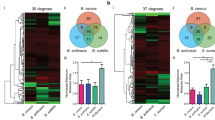Abstract
A chemically defined medium (BGDM) has been developed specifically forBacteroides gingivalis. The medium contains 4 amino acids, 5 mineral salts, cysteine hydrochloride as a reducing agent, and the growth factors hemin and menadione. Eight strains ofB. gingivalis have been subcultured repeatedly in this medium with no apparent changes in colonial or cellular morphology. The metabolic end products of strains grown in this medium were reproducible and yielded patterns similar to those produced by cells cultured in complex media. The growth rates were about 50% slower than those of cells grown in a complex medium, and the growth rate constants ranged between 0.013 and 0.067 H−1. When the defined medium was supplemented with protein hydrolysates such as trypticase, proteose peptone, bactocasitone, or yeast extract, at concentrations up to 1.0%, growth increased. No such growth increase was observed in the medium supplemented with casamino acids. Thus a minimal medium can be formulated by adding one of the growth-enhancing protein hydrolysates to the defined medium at varying concentrations depending upon the growth yield required.
Similar content being viewed by others
Literature Cited
Bryant MP (1974) Nutritional features and ecology of predominant anaerobic bacteria of the intestinal tract. Am J Clin Nutr 27:1313–1319
Bryant MP, Robinson IM (1962) Some nutritional characteristics of predominant culturable ruminal bacteria. J Bacterol 84:605–614
Carlsson J (1973) Simplified gas chromatographic procedure for identification of bacterial metabolic products. Appl Microbiol 25:287–289
Holdeman LV, Kelley RW, Moore WEC (1984) Genus Bacteroides Castellini and Chalmers 1919. In: Kreig NR, Holt JC (eds) Bergey's manual of systematic bacteriology, vol. 1. Baltimore: Williams and Wilkins
Hungate RE (1966) The rumen and its microbes. Academic Press, p 281–351
Macy J, Probst I, Gottschalk G (1975) Evidence for cytochrome involvement in fumarate reduction and adenosine 5′-triphosphate synthesis byBacteroides fragilis grown in the presence of hemin. J Bacteriol 123:436–442
McKee AS, McDermid AS, Baskerville A, Dowsett AB, Ellwood DC, Marsh PD (1986) Eflect of hemin on the physiology and virulence ofBacteroides gingivalis W50. Infect Immun 52:349–355
Shah HN, Collins MD (1980) Fatty acid and isoprenoid quinone composition in the classification ofBacteroides melaninogenicus and related taxa. J Appl Bacteriol 48:75–87
Shah HN, Williams RAD (1982) Dehydrogenase patterns in the taxonomy ofBacteroides. J Gen Microbiol 128:2955–2965
Shah HN, Williams RAD (1987) Utilisation of glucose and amino acids byBacteroides intermedius andBacteroides gingivalis. Curr Microbiol 15:241–246
Shah HN, Williams RAD (1987) Catabolism of aspartate and asparagine byBacteroides intermedius andBacteroides gingivalis. Curr Microbiol 15:313–318
Shah HN, Williams RAD, Bowden GH, Hardie JM (1976) Comparison of the biochemical properties ofBacteroides melaninogenicus from human dental plaque and other sites. J Appl Bacteriol 41:473–492
Shah HN, Nash RA, Hardie IM, Wheetman DA, Geddes DA, MacFarlane TW (1985) Detection of acidic end products of metabolism of anaerobic, Gram-negative bacteria. In: Goodfellow M, Minnikin DE (eds) Chemical methods in bacterial systematics London: Academic Press, pp 317–340
Slots J, Bragd L, Wikstrom M, Dahlen G (1986) The occurrence ofActinobacillus actinomycetemcomitans, Bacteroides gingivalis andBacteroides intermedius in destructive periodontal disease in adults. J Clin Periodontal 13:570–577
Socransky SS, Dzink JL, Smith CM (1985) Chemically defined medium for oral microorganisms. J Clin Microbiol 22:303–305
Sundqvist G, Eckerbom MI, Larsson AP, Sjogren UT (1979) Capacity of anaerobic bacteria from necrotic dental pulps to induce purulent infections. Infect Immun 25:685–693
Van Steenbergen TJM, Kalstelein P, de Graff J (1982) Virulence of black pigmented bacteroides strains from periodontal pockets and other sites in experimentally induced skin lesions in mice. J Periodont Res 17:41–49
White D, Mayrand D (1981) Association of oral bacteroides with gingivitis and adult periodontitis. J Periodont Res 16:259–265
Author information
Authors and Affiliations
Rights and permissions
About this article
Cite this article
Seddon, S.V., Shah, H.N., Hardie, J.M. et al. Chemically defined and minimal media forBacteroides gingivalis . Current Microbiology 17, 147–149 (1988). https://doi.org/10.1007/BF01573470
Issue Date:
DOI: https://doi.org/10.1007/BF01573470




